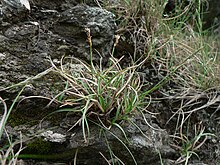Carex rupestris
| Carex rupestris | |
|---|---|

| |
| On a mountainside in the Czech Republic | |
| Scientific classification | |
| Kingdom: | Plantae |
| Clade: | Tracheophytes |
| Clade: | Angiosperms |
| Clade: | Monocots |
| Clade: | Commelinids |
| Order: | Poales |
| Family: | Cyperaceae |
| Genus: | Carex |
| Species: | C. rupestris
|
| Binomial name | |
| Carex rupestris | |
| Subspecies[2] | |
| |
| Synonyms[2] | |
|
subsp. altimontana[3]
subsp. rupestris[4] | |
Carex rupestris, called the curly sedge and rock sedge (names it shares with other members of its genus), is a species of flowering plant in the family Cyperaceae, native to temperate and subarctic North America, Greenland, Iceland, Europe, and Asia.[2]
Description
[edit]Carex rupestris is a type of sedge, growing between 10–20 centimetres (4–8 inches) in height. It grows in dense, matted tufts.[5] Rhizome branch lengths measure 0.4–5.0 cm (0.2–2.0 in). Aerial shoots ascend from the rhizome, with dead leaves persisting for several years and giving the stands a typical straw-yellow colour, recognizable at a distance.[5] Leaves are up to 2 millimetres (0.08 inches) wide and channelled, appearing at the base of the stem. The inflorescence is composed of a single spike at the top of the stem.[6] Rhizomes are brown or black, with a scaly appearance. The species fruits in late spring to summer.[7]
Distribution and habitat
[edit]Carex rupestris is an arctic-alpine species found at higher altitudes. It favours dry ground, heathland, talus slopes, and rocky outcrops and ledges.[8][7] Carex rupestris subsp. altimontana is found only in the Altai Republic of Russia.[3]
Taxonomy
[edit]The following subspecies are currently accepted:[2]
- Carex rupestris subsp. altimontana T.V.Ebel
- Carex rupestris subsp. rupestris
Conservation
[edit]Carex rupestris is considered an endangered species across the Carpathian Mountains due to the effect of climate change.[9] It is extirpated in Bulgaria.[2] In North America, as of November 2024[update], NatureServe listed C. rupestris as Globally Secure (G5). This status was last reviewed on 15 July 2016. In individual provinces and states, it is listed as Critically Imperiled (S1) in South Dakota; Imperiled (S2) in Manitoba, Ontario, and Quebec; and, Vulnerable (S3) in Alberta and Newfoundland.[1]
References
[edit]- ^ a b "Carex rupestris Rock Sedge". NatureServe Explorer (explorer.natureserve.org). NatureServe. 1 November 2024. Retrieved 6 November 2024.
- ^ a b c d e f g "Carex rupestris All". Plants of the World Online. Royal Botanic Gardens, Kew. Retrieved 6 November 2024.
- ^ a b "Carex rupestris subsp. altimontana T.V.Ebel". Plants of the World Online. Royal Botanic Gardens, Kew. Retrieved 6 November 2024.
- ^ "Carex rupestris subsp. rupestris". Plants of the World Online. Royal Botanic Gardens, Kew. Retrieved 6 November 2024.
- ^ a b "Carex rupestris". svalbardflora.no. Retrieved 3 November 2024.
- ^ "Plants of Iceland: Carex rupestris, Rock Sedge, Móastör". www.iceland-nh.net. Retrieved 3 November 2024.
- ^ a b "SERNEC - Carex rupestris". sernecportal.org. Retrieved 4 November 2024.
- ^ Chlebicki, Andrzej (2014). "Biogeographic relationships between fungi and selected glacial relict plants". Monographiae Botanicae. 90: 1–230. doi:10.5586/mb.2002.001.
- ^ Svitková, Ivana; Svitok, Marek; Petrík, Anton; Bernátová, Dana; Senko, Dušan; Šibík, Jozef (September 2019). "The Fate of Endangered Rock Sedge (Carex rupestris) in the Western Carpathians—The Future Perspective of an Arctic-Alpine Species under Climate Change". Diversity. 11 (9): 172. doi:10.3390/d11090172. ISSN 1424-2818.
- NatureServe secure species
- Carex
- Flora of Europe
- Flora of the North Caucasus
- Flora of Siberia
- Flora of Kazakhstan
- Flora of the Russian Far East
- Flora of Mongolia
- Flora of Korea
- Flora of Subarctic America
- Flora of Western Canada
- Flora of Eastern Canada
- Flora of the Northwestern United States
- Flora of South Dakota
- Flora of Utah
- Flora of New Mexico
- Plants described in 1785

